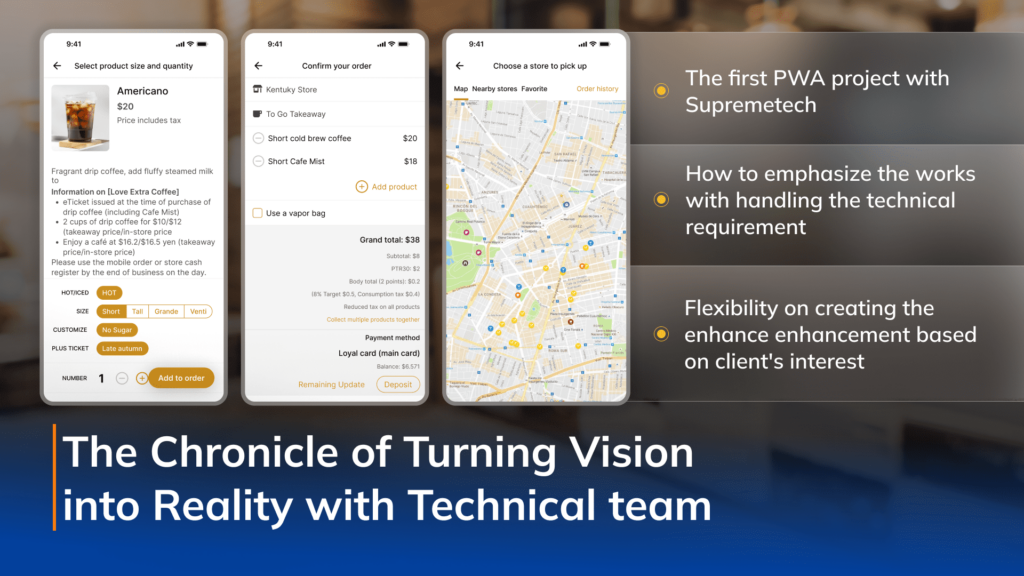Online Retailing Triumph #3: Transformation for a Japanese Coffee Chain
08/09/2023
1.16k
Table of Contents
Discover how a Japanese coffee chain seamlessly transitioned to online success. SupremeTech is delighted to join as a development partner for the web upgrade project. Through Progressive Web App technology, holiday orders soared to 3,000 in a day.
Explore other case studies:
- Online Retailing Triumph #1: Explore Modern Offshore with SupremeTech & Classmethod
- Online Retailing Triumph #2: Success Comes from Small Features
- Enhancement of Mobile Order Experience for A Coffee Chain
Once Upon a Time in Coffee-land: A Tale of Innovation and Transformation
In Japan, the scent of coffee filled the air, mixing with the murmurs of technological progress. It all started with a top Japanese coffee chain set on combining tradition and modernity. This captivating story tells of a brand that looked beyond just coffee cups, envisioning a digital world full of potential.

Not content with the current order app, the renowned coffee chain has been exploring new methods of coffee ordering since 2020.
Whispers of Change: How a Web Upgrade Creates Magic Into Holiday Orders
During Japan’s festive holidays, the coffee chain aimed to delight customers in a fresh way. A web upgrade revolutionized the ordering process, shifting from an app to a Progressive Web App (PWA). The impact was remarkable, with holiday orders reaching an unprecedented 3,000 in a single day. A simple coffee sip transformed into an innovative experience.

So, what brought magic to the coffee chain’s revenue along with the new way of approaching customers? Let’s find out what we have worked on to create success!
Creating Delightful Experiences: The Intersection of User Interface and User Experiences
In the digital shift, the user interface (UI) became crucial in shaping user experiences.
Maintaining consistency across every item in the system is vital. Working closely with the client, the development team carefully designed UI components that reflected the brand’s core identity. This is the focus of the SupremeTech team even before any code is written.
With every click and swipe, customers entered a delightful journey where aesthetics and functionality came together to create memorable experiences.
Step by Step, Heart to Heart: The Chronicle of Turning Vision into Reality with PWA’s Technical

The first PWA project of SupremeTech
Behind this narrative of success stood SupremeTech’s technical process, the architects of this digital evolution. With our first PWA project, we embraced challenges, defying limitations with ingenuity. SupremeTech’s efforts laid the foundation for a retail transformation from aligning with technical requirements to ensuring seamless integration.
Flexibility is key
The technical journey wasn’t just about code; it was about understanding the brand’s identity and translating it into a digital language. SupremeTech’s commitment to customization, seamless navigation, and lightning-fast responsiveness redefined digital interaction, ensuring that each virtual coffee order was a taste of perfection.
Moreover, we allow users to create their own events and promotions. We crafted a seamless solution, making it easier than ever for the client to take the reins. With the introduction of a user-friendly URL and tools, the coffee chain found itself with a dynamic canvas at its fingertips.
This novel approach revolutionized content management. Recognizing the need for agility in an ever-evolving digital landscape, SupremeTech handed the power of content creation to the client. The days of waiting for technical tweaks were gone, replaced by a swift and straightforward system that allowed our client to curate and update content anytime.
The coffee chain’s virtual realm became a dynamic playground where offers and events waltzed in harmony, captivating the audience at every turn. This newfound agility created a bond of loyalty and excitement, a testament to the synergy between SupremeTech’s innovation and the coffee chain’s commitment to enhancing the user experience.
Development systems and technologies
Below are the resources and technologies we use to develop the services:
Details of entrustment: Design, Implementation, Testing, Migration & Maintenance
Platform: Web
Development language: PHP, Javascript
Let Supremetech help you to start the system now!
Start investing in your “magic start” now with the help of Supremetech. Our expertise and solutions will empower you to request!
Don’t wait, take the first step towards digitizing your customer service now!
Book a free consultation with us now!
Related Blog





















